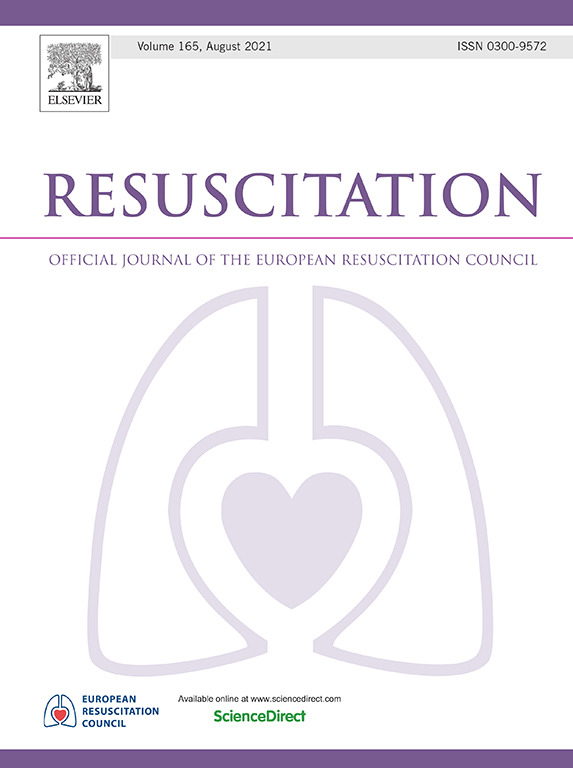Bystander cardiopulmonary resuscitation and outcomes of mass cardiac arrests caused by a crowd crush
IF 6.5
1区 医学
Q1 CRITICAL CARE MEDICINE
引用次数: 0
Abstract
Introduction
A crowd crush can lead to respiratory arrest and result in multiple mass cardiac arrests (MCAs), which are often classified as Black Tag in disaster triage. Recently, many laypersons have been commonly trained in compression-only cardiopulmonary resuscitation (CPR) without ventilation support in various communities. This study aims to describe the characteristics of bystander CPR administered and the outcomes of MCAs during the Itaewon crowd crush incident.
Methods
An observational study was conducted on the CPR characteristics of MCAs during the Halloween Festival in 2022, utilizing two databases: (1) MCAs registered in the Korea Out-of-Hospital Cardiac Arrest Registry (KOHCAR) and (2) MCAs uploaded on social media platforms (Instagram and YouTube), identified through relevant keyword searches. Video clips with a minimum streaming time of 10 s and a clear view of bystander CPR were analyzed. General demographic findings were analyzed using the KOHCAR, while the type of bystander CPR (compression-only CPR with or without rescue breathing) was compared using the social media data.
Results
Of the 218 patients attended by EMS, 119 MCAs were registered in KOHCAR. The mean age of the victims was 24.5 years, with 10 (8.4%) being non-Korean. The median ambulance response time was 59 min. Among the victims, 22 (18.5%) received CPR (19 bybystanders, 2 by first responders, and 1 by a disaster medical assistant team), followed by EMS resuscitation, while 7 (5.9%) received CPR first by the EMS team. The remaining 90 victims (75.6%) were pronounced deceased by EMS providers. Three victims (2.5%) achieved return of spontaneous circulation (ROSC) in the field, and one (0.8%) survived to hospital discharge. From the social media database, 26 video clips containing CPR were identified (14 from 251 clips on Instagram and 12 from 187 on YouTube), excluding duplicates and non-CPR cases. In the 26 video clips containing CPR, a total of 228 bystander CPR cases were identified in the video clips. Of these, 217 (95.2%) involved compression-only CPR, while 11 cases (4.8%) included CPR with rescue breathing.
Conclusion
Most MCAs were pronounced deceased, likely due to their classification as Black Tag or delayed response times. Only a small percentage (4.8%) of bystander CPR cases included rescue breathing. An optimized resuscitation protocol for MCAs in crowd crush scenarios should be developed.
人群挤压引起的大量心脏骤停的旁观者心肺复苏和结果。
人群挤压可导致呼吸骤停,并导致多次大规模心脏骤停(MCAs),这在灾难分类中通常被归类为黑色标签。最近,在不同的社区中,许多外行人通常接受无通气支持的单纯按压心肺复苏(CPR)培训。本研究旨在描述梨泰院人群挤压事件中实施的旁观者心肺复苏术的特点和MCAs的结果。方法:对2022年万圣节期间MCAs的心肺复苏特征进行观察性研究,利用两个数据库:(1)在韩国院外心脏骤停登记处(KOHCAR)登记的MCAs和(2)上传于社交媒体平台(Instagram和YouTube)上的MCAs,通过相关关键词搜索识别。研究人员分析了至少10秒的视频片段和旁观者心肺复苏的清晰画面。使用KOHCAR分析一般人口统计结果,同时使用社交媒体数据比较旁观者心肺复苏术的类型(仅按压心肺复苏术,有或没有抢救呼吸)。结果:218例急诊患者中,有119例MCAs在KOHCAR中登记。受害者的平均年龄为24.5岁,其中非韩国人10人(8.4%)。救护车反应时间中位数为59分钟。其中,22例(18.5%)患者接受了CPR(旁观者19例,急救人员2例,灾难医疗助理团队1例),其次是EMS复苏,而7例(5.9%)患者首先接受了EMS复苏。其余90名受害者(75.6%)由急救服务提供者宣布死亡。3名患者(2.5%)在现场恢复了自发循环(ROSC), 1名患者(0.8%)存活至出院。从社交媒体数据库中,确定了26个包含心肺复苏术的视频片段(Instagram上的251个片段中有14个,YouTube上的187个片段中有12个),排除了重复和非心肺复苏术的案例。在26个包含心肺复苏术的视频片段中,共识别出228个旁观者心肺复苏术案例。其中,217例(95.2%)为单纯按压式心肺复苏,11例(4.8%)为心肺复苏合并人工呼吸。结论:大多数mca被宣布死亡,可能是由于他们的分类为黑色标签或延迟反应时间。只有一小部分(4.8%)的旁观者CPR病例包括抢救呼吸。应制定针对人群挤压情况下mca的优化复苏方案。
本文章由计算机程序翻译,如有差异,请以英文原文为准。
求助全文
约1分钟内获得全文
求助全文
来源期刊

Resuscitation
医学-急救医学
CiteScore
12.00
自引率
18.50%
发文量
556
审稿时长
21 days
期刊介绍:
Resuscitation is a monthly international and interdisciplinary medical journal. The papers published deal with the aetiology, pathophysiology and prevention of cardiac arrest, resuscitation training, clinical resuscitation, and experimental resuscitation research, although papers relating to animal studies will be published only if they are of exceptional interest and related directly to clinical cardiopulmonary resuscitation. Papers relating to trauma are published occasionally but the majority of these concern traumatic cardiac arrest.
 求助内容:
求助内容: 应助结果提醒方式:
应助结果提醒方式:


